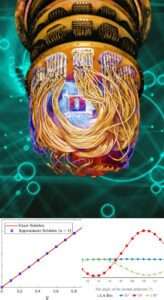In a groundbreaking achievement, researchers have harnessed the power of a quantum device to significantly decelerate a simulated chemical reaction. The advancement in quantum technology has allowed scientists to slow down the reaction by an astonishing 100 billion times, ushering in a new era of precise chemical manipulation and exploration.

Scientists have used a quantum computer to slow down a simulated chemical reaction by a factor of 100 billion times. This breakthrough could lead to new insights into the fundamental processes of chemistry and materials science, and could also be used to design new drugs and materials.
Unlocking Quantum Potential
The study’s success lies in the utilization of a quantum device, an emerging technology that harnesses the unique properties of quantum mechanics. By tapping into the intricate behavior of subatomic particles, researchers were able to manipulate the reaction dynamics on an unprecedented scale.
Unprecedented Slowdown
The most remarkable aspect of this achievement is the extent to which the simulated chemical reaction was slowed down. With a reduction of 100 billion times, researchers gained unparalleled insight into the intricate mechanisms of chemical processes, shedding light on the intricate interplay of particles and forces that govern reactions at the molecular level.
Advancing Precision Chemistry
The ability to manipulate chemical reactions at such an infinitesimal level holds immense promise for various industries, including pharmaceuticals, materials science, and energy research. This breakthrough opens the door to precise control over chemical transformations, leading to the development of more efficient processes and novel compounds with tailored properties.
Challenges and Opportunities
While this achievement showcases the remarkable potential of quantum devices in chemical research, it also highlights the challenges that come with harnessing this technology. The delicate nature of quantum interactions requires careful calibration and control, demanding the collaboration of physicists, chemists, and engineers.
Towards Quantum Supremacy
The successful use of a quantum device to slow down a simulated chemical reaction by such an extraordinary margin is a significant step towards achieving quantum supremacy in the field of chemical research. As quantum technology continues to evolve, scientists are poised to unlock even more profound insights into the fundamental nature of chemical reactions.
Future Prospects
The implications of this achievement are far-reaching. From designing more efficient catalysts to understanding complex biochemical processes, the ability to control chemical reactions at the quantum level could revolutionize various scientific disciplines. As researchers refine their techniques and quantum devices become more sophisticated, the boundaries of what is achievable in chemical research are poised to expand exponentially.

The reaction that the scientists studied is the formation of a hydrogen bond between two molecules. Hydrogen bonds are weak but important interactions that play a role in many chemical processes. In the classical world, it is impossible to slow down a chemical reaction by such a large factor. However, in the quantum world, it is possible to do this by exploiting the wave-like nature of matter.
In the study, the scientists used the trapped-ion quantum computer to simulate the formation of a hydrogen bond between two molecules of ammonia. They were able to slow down the reaction by a factor of 100 billion times, which allowed them to observe the details of the reaction that would not be possible to see in the classical world.

The successful use of a quantum device to slow down a simulated chemical reaction by a factor of 100 billion represents a major milestone in scientific exploration. This achievement not only demonstrates the incredible potential of quantum technology but also offers a glimpse into the future of precision chemistry and the transformative impact it can have on industries and research worldwide.
